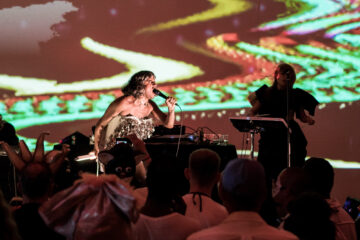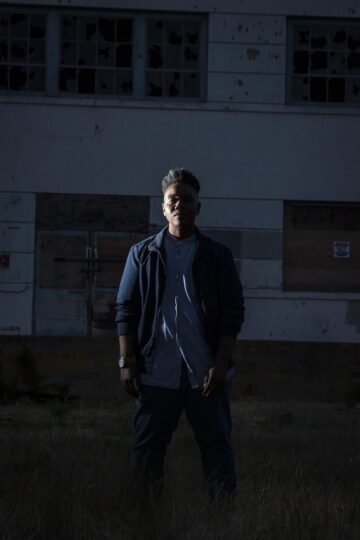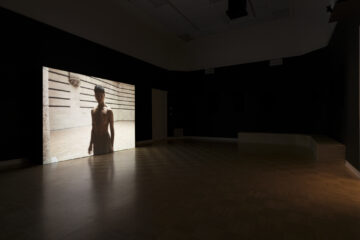In A window to the see..., Raúl de Nieves (b. 1983 in Morelia, Michoacán, Mexico; lives and works in Brooklyn, New York) presents an interplay of colored light and poetic prompts to guide visitors on a journey of continual transformation. Using the everyday materials of acetate and tape, the Brooklyn-based artist has custom-fit his signature “stained glass” to the three immense skylights that span the gallery. The lucent window panels transmute the transitional natural light, creating an ever-changing atmosphere inside the gallery, while illuminating a narrative of perpetual becoming told through images of colossal archetypes. For de Nieves, the imagery is symbolic of the relationship between the earthly, bodily, material realm and the metaphysical, spiritual, ancestral one. By bringing these dimensions together, the artist invites us to imagine what a celestial landscape could be and to temporarily inhabit this infinity of possibility.
Throughout his practice, de Nieves uses humble, mundane, or castoff materials, refashioning and revaluing the commonplace to create dazzling new forms that animate the potential for evolution and multiplicity of the self. Working across the mediums of painting, sculpture, performance, sound, and installation, his densely textured works draw from personal and collective mythologies that often evoke forms of ritual and celebration. By fusing the aesthetic traditions of Mexican craft, Catholicism, the Tarot, the canon of European art, drag performance, and punk music, de Nieves mines enduring narratives for themes of self-actualization and rebirth. The figural bead sculptures in the exhibition The Deaths of Everyday and Celebration (mother) embody this process of regeneration. De Nieves manifests these sculptures from artworks previously either intentionally destroyed or accidentally damaged, engaging the potential of renewal from fracture.
The exhibition title, A window to the see, A spirit star chiming in the wind of wonder…, is also the first line in a poem written by de Nieves while making the “stained glass.” Each stanza of the poem corresponds to one of the twenty-one window panels. Wrapping the interior of the gallery, the poem invites circumambulation of the space and meditative, inner reflection, while the temple-like seating arrangement at the center of the gallery offers an opportunity to spend extended time in contemplation of the windows above. As an immersive experience, de Nieves’s installation is a portal to an alternative world, inspired by the power and possibility of wonder and imagination in daily life.


![<p><em>Raúl de Nieves: A window to the see, a spirit star chiming in the wind of wonder…</em> [Installation view, Henry Art Gallery, University of Washington, Seattle. 2023]. Photo: Jonathan Vanderweit.</p>](https://henryart.org/assets/img/_smallImage/20231004_Raúl-de-Nieves_0317.jpg)

![<p>Raúl de Nieves: A window to the see, a spirit star chiming in the wind of wonder… [Installation view, Henry Art Gallery, University of Washington, Seattle. 2023]. Photo: Jonathan Vanderweit.</p>](https://henryart.org/assets/img/_smallImage/20231004_Raúl-de-Nieves_0117.jpg)
![<p>Raúl de Nieves: A window to the see, a spirit star chiming in the wind of wonder… [Installation view, Henry Art Gallery, University of Washington, Seattle. 2023]. Photo: Jonathan Vanderweit.</p>](https://henryart.org/assets/img/_smallImage/20231004_Raúl-de-Nieves_0011.jpg)
![<p>Raúl de Nieves. <em>m</em><em>urmurs of water as it has carved the faces of the mountain / NO ONE KNOWS / those traveling across the plains, he has two names: one is One</em> [detail], 2023. Acetate panels on wooden frames. Courtesy of the artist; Company Gallery, New York; and Morán Morán. Installation view of <em>Raúl de Nieves: A window to the see, a spirit star chiming in the wind of wonder…</em>, 2023, Henry Art Gallery, University of Washington, Seattle. Photo: Jonathan Vanderweit.</p>](https://henryart.org/assets/img/_smallImage/20231004_Raúl-de-Nieves_0017-cropped.jpg)


![<p>Raúl de Nieves, <em>Murmurs of water as it has carved the faces of the mountain / NO ONE KNOWS / those traveling across the plains, he has two names: one is One </em>[detail], 2023. Acetate panels on wooden frames. Courtesy of the Artist and Company Gallery, New York.</p>](https://henryart.org/assets/img/_smallImage/RDN315_High_01_230830_111314.jpg)
![<p><em>Sophia Al-Maria: Not My Bag</em> [Installation view, Henry Art Gallery, University of Washington, Seattle. 2023]. Photo: Jueqian Fang.</p>](https://henryart.org/assets/img/_smallImage/Henry-20230725-33.jpg)

